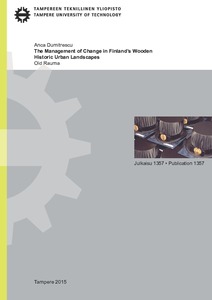The Management of Change in Finland's Wooden Historic Urban Landscapes: Old Rauma
Dumitrescu, Anca (2016)
Dumitrescu, Anca
Tampere University of Technology
2016
Tieto- ja sähkötekniikan tiedekunta - Faculty of Computing and Electrical Engineering
This publication is copyrighted. You may download, display and print it for Your own personal use. Commercial use is prohibited.
Julkaisun pysyvä osoite on
https://urn.fi/URN:ISBN:978-952-15-3675-5
https://urn.fi/URN:ISBN:978-952-15-3675-5
Tiivistelmä
The present research elaborates the Architectural and Urban perspective on the multidisciplinary approach of the Historic Urban Landscapes, in the Fennoscandian cultural context.
The main purpose of the present study is to define and to clarify how to limit and control change in the wooden historic urban landscapes found in a specific cultural region: Finland. Managing change in the context of the thesis gathers a wide area of possible attitudes in relation to historic urban areas, including: non-intervention, intervention by conservation, development, protection, demolition or re-building. In order to adequately answer the question, one must clarify what ‘change’, ‘historic urban landscape’ and ‘wooden [town]’ imply, as well as a number of other underlying concepts.
The main focus of the study is Old Rauma – a World Heritage site since 1991, viewed in a larger context: the cultural region of the Fennoscandia. Therefore, special attention is given to UNESCO wooden urban heritage, as it represents the most valuable and, at the same time, vulnerable and delicate form of historic urban landscape discussed and managed in contemporary practice. The role and impact of the recognition of World Heritage Sites is considered mainly through the comparative analysis of similar sites in the Nordic Countries. The narrower cultural context of Old Rauma is analysed through study cases of other historic urban areas of Finland. Defining a way to deal with change in wooden historic urban areas considered from the historic urban landscape perspective in the Nordic cultural context is one of the goals of this research, starting with the particularities and valued traits of these sites. In order to achieve a broader view on the phenomenon of the wooden historic urban landscape, the considered study cases are both World Heritage Sites as well as Finnish historic towns bearing enough similarities to be analysed in the same category.
The validity of the proposed tool: the Aggregated Management Plan for Finnish historic urban areas considering the historic urban landscape approach is supported by case studies and the elaboration of the plan for Old Rauma.
The main purpose of the present study is to define and to clarify how to limit and control change in the wooden historic urban landscapes found in a specific cultural region: Finland. Managing change in the context of the thesis gathers a wide area of possible attitudes in relation to historic urban areas, including: non-intervention, intervention by conservation, development, protection, demolition or re-building. In order to adequately answer the question, one must clarify what ‘change’, ‘historic urban landscape’ and ‘wooden [town]’ imply, as well as a number of other underlying concepts.
The main focus of the study is Old Rauma – a World Heritage site since 1991, viewed in a larger context: the cultural region of the Fennoscandia. Therefore, special attention is given to UNESCO wooden urban heritage, as it represents the most valuable and, at the same time, vulnerable and delicate form of historic urban landscape discussed and managed in contemporary practice. The role and impact of the recognition of World Heritage Sites is considered mainly through the comparative analysis of similar sites in the Nordic Countries. The narrower cultural context of Old Rauma is analysed through study cases of other historic urban areas of Finland. Defining a way to deal with change in wooden historic urban areas considered from the historic urban landscape perspective in the Nordic cultural context is one of the goals of this research, starting with the particularities and valued traits of these sites. In order to achieve a broader view on the phenomenon of the wooden historic urban landscape, the considered study cases are both World Heritage Sites as well as Finnish historic towns bearing enough similarities to be analysed in the same category.
The validity of the proposed tool: the Aggregated Management Plan for Finnish historic urban areas considering the historic urban landscape approach is supported by case studies and the elaboration of the plan for Old Rauma.
Kokoelmat
- Väitöskirjat [4769]
